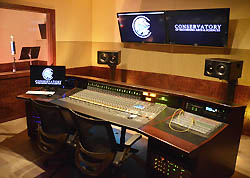
Two new control rooms at the Conservatory of Recording Arts and Sciences (CRAS), a top-tier technical school in Gilbert, AZ that’s dedicated to placing its students in entry-level pro audio positions, are outfitted with ATC SCM25A Pro reference monitors, distributed in the U.S. by TransAudio Group.
“Our rooms reflect reality in the industry,” says Tony Nunes, music production instructor and manufacture liaison at CRAS. Nunes, together with Mike Jones, director of education, travels to trade shows, recording studios, and post-production facilities around the country to keep CRAS’s facilities and instruction in perfect synchrony with the latest (and enduring) industry standards.
“We sculpt our technology and instruction to remain always at the current standards in the industry,” he continues. “Two years ago at AES in New York City, we visited a lot of the big studios in town, like Stadium Red and Electric Ladyland, and talked with our grads who worked there. A consistent theme that studio managers/staff stressed was the persistent requests they received for ATC monitors; so persistent, in fact, that most studios invested in their own ATCs.”
The ATC SCM25As at CRAS join Pro Tools HDX rigs with Apogee converters, [soundBlade HD] rigs with Mytek converters, and SSL AWS 948 combined console and control surfaces.
“The ATCs are certainly the most transparent monitors we have at CRAS,” states Nunes. “Students don’t get to studios F and G until they are a little ways into the program. By that time, they can really appreciate the details that the ATCs reveal. For example, when we’re tracking in those control rooms, students will notice the smallest details, like fret buzz on the bass.
“One time we had a vocalist who was struggling with an allergy and sinus problem. After he rested and had some tea, he came back and all the students could really hear the physicality of the difference. One student said it was like he could see the vocal cords in the ATCs. They’re a really great tool.”
Because students use the ATC SCM25A Pros later in the program, they get an opportunity to scrutinize their earlier projects. “They know so much more six months later, and now they’ve got these great monitors that reveal so much; it can often be a painful experience,” Nunes explains. “But we turn it into a learning experience. We find and analyze the mistakes, and then students may remix their projects. Every time, they come back happy with the results. Because the new mixes pass the test on the ATCs, they translate everywhere else, like students’ cars, apartments and computers.”
TransAudio Group
Conservatory of Recording Arts and Sciences (CRAS)
